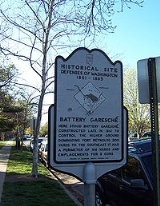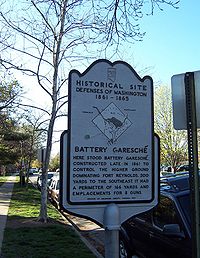
Battery Garesche
Encyclopedia
Battery Garesche or Battery Garesché was a Union Army
artillery battery
built as part of the defenses of Washington, D.C.
in the American Civil War
at what is now Abingdon Street at South 30th Road in Fairlington
, Arlington County
, Virginia
. It was constructed in late 1861 to control the high ground over Fort Reynolds
, 200 yards (200 m) to the southeast, and to protect it from Confederate
attack from positions on Seminary Ridge. It had a perimeter of 166 yards (152 m) and emplacements for 8 gun
s. Although located in Virginia, a Confederate state, this was part of the area near Washington that was never controlled by Confederate forces.
 The battery was named after Lieutenant Colonel Julius P. Garesché who was killed on 31 December 1862 at the Battle of Stones River
The battery was named after Lieutenant Colonel Julius P. Garesché who was killed on 31 December 1862 at the Battle of Stones River
in Tennessee
.
The battery no longer exists and is now noted only with a historical marker
.
Another Battery Garesché commemorated the deceased lieutenant colonel much later at Fort Williams, in Cape Elizabeth, Maine
. It was a concrete shore battery which contained two disappearing 6-inch (155 mm) guns
. Built in 1906, its armed existence was brief, as its guns were removed for use on the Western Front in World War I
.
Union Army
The Union Army was the land force that fought for the Union during the American Civil War. It was also known as the Federal Army, the U.S. Army, the Northern Army and the National Army...
artillery battery
Artillery battery
In military organizations, an artillery battery is a unit of guns, mortars, rockets or missiles so grouped in order to facilitate better battlefield communication and command and control, as well as to provide dispersion for its constituent gunnery crews and their systems...
built as part of the defenses of Washington, D.C.
Washington, D.C.
Washington, D.C., formally the District of Columbia and commonly referred to as Washington, "the District", or simply D.C., is the capital of the United States. On July 16, 1790, the United States Congress approved the creation of a permanent national capital as permitted by the U.S. Constitution....
in the American Civil War
American Civil War
The American Civil War was a civil war fought in the United States of America. In response to the election of Abraham Lincoln as President of the United States, 11 southern slave states declared their secession from the United States and formed the Confederate States of America ; the other 25...
at what is now Abingdon Street at South 30th Road in Fairlington
Fairlington, Virginia
Fairlington is an unincorporated neighborhood in Arlington County, Virginia, United States, located adjacent to Shirlington in the southernmost part of the county on the boundary with the City of Alexandria...
, Arlington County
Arlington County, Virginia
Arlington County is a county in the Commonwealth of Virginia. The land that became Arlington was originally donated by Virginia to the United States government to form part of the new federal capital district. On February 27, 1801, the United States Congress organized the area as a subdivision of...
, Virginia
Virginia
The Commonwealth of Virginia , is a U.S. state on the Atlantic Coast of the Southern United States. Virginia is nicknamed the "Old Dominion" and sometimes the "Mother of Presidents" after the eight U.S. presidents born there...
. It was constructed in late 1861 to control the high ground over Fort Reynolds
Fort Reynolds (Virginia)
Fort Reynolds was a Union Army redoubt built as part of the defenses of Washington, D.C., in the American Civil War.The fort was located in Fairlington, Arlington County, Virginia. It was constructed in September 1861 to command the approach to Alexandria by the Four Mile Run valley and was itself...
, 200 yards (200 m) to the southeast, and to protect it from Confederate
Confederate States of America
The Confederate States of America was a government set up from 1861 to 1865 by 11 Southern slave states of the United States of America that had declared their secession from the U.S...
attack from positions on Seminary Ridge. It had a perimeter of 166 yards (152 m) and emplacements for 8 gun
Gun
A gun is a muzzle or breech-loaded projectile-firing weapon. There are various definitions depending on the nation and branch of service. A "gun" may be distinguished from other firearms in being a crew-served weapon such as a howitzer or mortar, as opposed to a small arm like a rifle or pistol,...
s. Although located in Virginia, a Confederate state, this was part of the area near Washington that was never controlled by Confederate forces.

Battle of Stones River
The Battle of Stones River or Second Battle of Murfreesboro , was fought from December 31, 1862, to January 2, 1863, in Middle Tennessee, as the culmination of the Stones River Campaign in the Western Theater of the American Civil War...
in Tennessee
Tennessee
Tennessee is a U.S. state located in the Southeastern United States. It has a population of 6,346,105, making it the nation's 17th-largest state by population, and covers , making it the 36th-largest by total land area...
.
The battery no longer exists and is now noted only with a historical marker
Historical marker
A historical marker or historic marker is an indicator such as a plaque or sign to commemorate an event or person of historic interest and to associate that point of interest with a specific locale one can visit.-Description:...
.
Another Battery Garesché commemorated the deceased lieutenant colonel much later at Fort Williams, in Cape Elizabeth, Maine
Cape Elizabeth, Maine
Cape Elizabeth is a town in Cumberland County, Maine, United States. The town is part of the Portland–South Portland–Biddeford, Maine metropolitan statistical area...
. It was a concrete shore battery which contained two disappearing 6-inch (155 mm) guns
Disappearing gun
A disappearing gun is a type of heavy artillery for which the gun carriage enabled the gun to rotate backwards and down into a pit protected by a wall or a bunker after it was fired...
. Built in 1906, its armed existence was brief, as its guns were removed for use on the Western Front in World War I
World War I
World War I , which was predominantly called the World War or the Great War from its occurrence until 1939, and the First World War or World War I thereafter, was a major war centred in Europe that began on 28 July 1914 and lasted until 11 November 1918...
.

